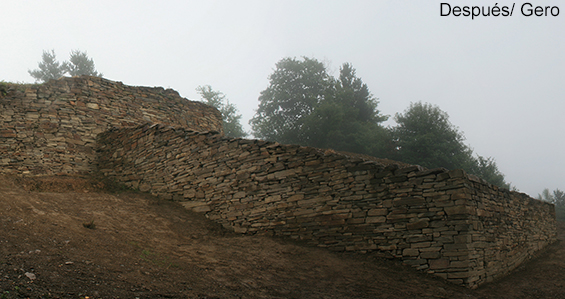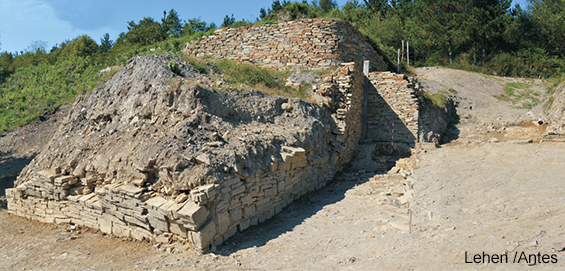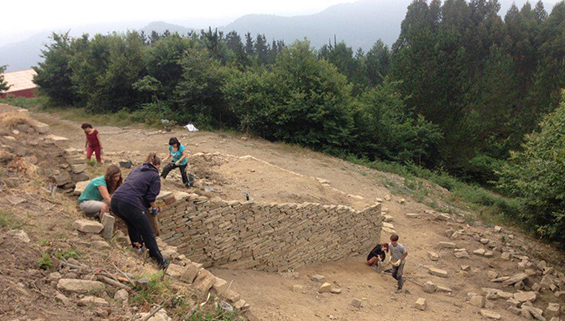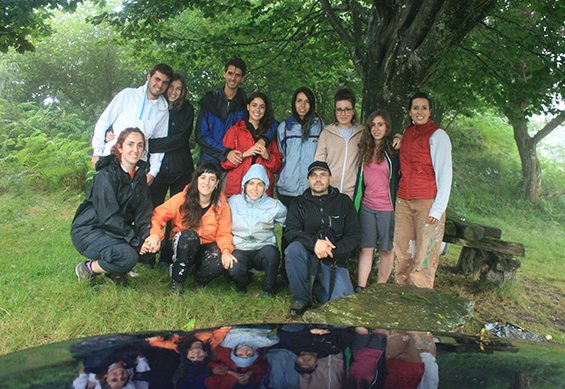
The Arrola Castro u “Oppidum” is an Iron Age site (3rd - 1st century B.C.), located in the Historical Territory of Bizkaia, on the summit of Arrola hill between the villages of Nabárniz, Arrazua and Mendata. Fernando Bazeta, an associate professor from the UPV/EHU Painting Department who has been working on its reconstruction for fourteen years, met us there.
The project began in 2001, with a study on the conservation status of the remains and some minimal relief reintegration work. From then on, the property owner, the Provincial Council of Bizkaia, funded annual archaeological and conservation-restoration campaigns, until 2009, when a university-company collaboration agreement was signed. This comprehensive R+D+innovation project involved archaeological research, restoration-conservation, and putting a scientific value on the site, with €480,000 being invested over 4 years. It is already possible to visit the Castro, with the original structure having been restored, enabling an overall vision and understanding of its historical characteristics.

Fernando’s work in 2015 involves the reconstruction of the southern entrance to the Castro (the reconstruction can be seen in the image at the start of this article), and we approach him for a chat about the work they are doing, and why their specialised knowledge and sensitive approach from the university is required. Conservationists and archaeologists have worked side by side throughout the years at Arrola. “The archaeologists find the wall surfaces and make notes”, recounts Fernando, but “after more than 2000 years, the wall surfaces are weak, lacking in structure, and difficult for an amateur observer to conceive”. That is when the conservationists come into play, given that they use an action protocol based on anastylosis, a reconstruction technique for ruined archaeological assets that uses a landmark’s own materials that are strewn around the area.

Fernando considers the “concept of authenticity” as particularly important in the restoration. “You can’t mislead the visitor or dream up what it could have looked like”. When reconstructing a wall, they use the same techniques as the original builders (known today as stretcher and header bond, with the blocks placed alternately, some on their longest side and others on the shortest side), and they mark their work with a colour code indicating the type of intervention. Grey, for example, indicates the material was relocated in the same and precise location but in a safe and stable manner, whilst red indicates the material used for the reconstruction of a particular section was not an exact replacement, but is still from the Castro itself.
“If we could meet with one of the original builders, we would want them to tell us that we are doing the same as they did,” stated Fernando on his working philosophy. He believes the concept of authenticity is the essential aspect to their intervention as we already mentioned, allied with the emotional investment of those involved, moved by a profound respect for the efforts made by other human beings over 2000 years ago.
When asked what Arrola has given to him personally, academically, and professionally, Fernando acknowledges “you become very involved over a period of 14 years. Arrola is already part of me to some extent. I know I have learnt so much here: building techniques, international documentation on archaeological reconstruction, conservation of cultural assets built in natural settings…” The value of the Oppidum de Arrola has given rise to both publications and teaching (on master and undergraduate degree courses). It has also opened up the route to intervention on other projects: the restoration of the Oma forest and several dolmen routes: Aizko (Karrantza), Muñarrikolanda (Unbe), and Katillotxu (Mundaka).

The research group that has worked on the different projects includes Teresa Escohotado Ibor, Ainhoa Rodríguez López, Natalia Blanco Álvarez, and Fernando himself. The UPV/EHU professor also extended his particular gratitude to the almost 200 students that have “sweated” alongside him in Arrola throughout the years and to the people from the Cultural Heritage Service in the Culture Department of the Provincial Council of Bizkaia who have promoted this project: Andoni Iturbe (Service manager), Zuriñe Antoñana (specialist restoration manager), and Mikel Unzueta (archaeologist).
Do you need an expert? Contact us
What is the benefit of contracting projects with companies?
¿Cómo puedo contratar proyectos con la Universidad?
Euskoiker has more than 30 years of experience managing all kinds of projects